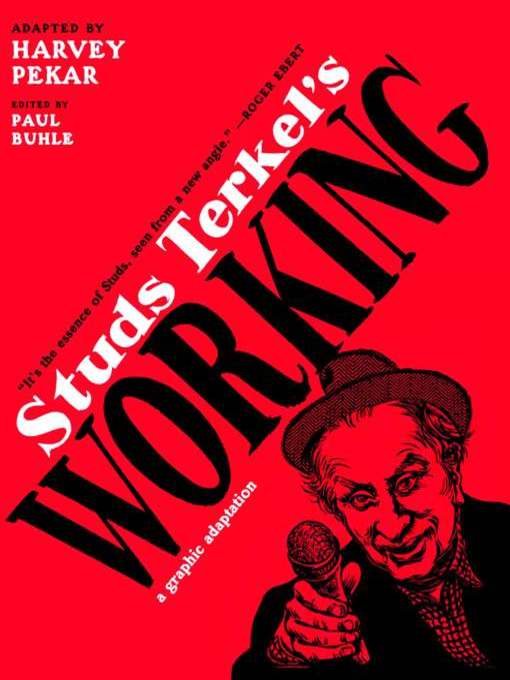
Studs Terkel's Working
A Graphic Adaptation
کتاب های مرتبط
- اطلاعات
- نقد و بررسی
- دیدگاه کاربران
نقد و بررسی

Starred review from April 13, 2009
Pekar (American Splendor
; Our Cancer Year
) adapts Terkel's masterpiece of oral history in this loving tribute. Working
features various artists, including Sharon Rudahl (A Dangerous Woman: the Graphic Biography of Emma Goldman
), Terry LaBan (Edge City
) and frequent Pekar collaborator Gary Dumm (Students for a Democratic Society: A Graphic History
). Though several of Pekar's colleagues have connections with the labor movement or activism, this volume does not push a particular political or social agenda. It simply adds dimension to Terkel's original, illustrating the daily concerns of working men and women. As is typical in collections, some of the pieces are stunning, while others merely adapt the story. Two standouts are “Jack Spiegel: Organizer” and “David Reed Glover: Stockbroker,” perfectly illustrated by Peter Gullerud and Pablo G. Callejo, respectively; Gollerud's stark woodcuts recall the art of the labor movement, while Callejo's meticulous detail and use of shading reflect the claustrophobia of a desk job. This collection will capture the interest of Pekar fans and Terkel aficionados alike, particularly in light of Terkel's death last year.

March 1, 2009
One of Terkel's best-known books takes on new life in graphic form courtesy of the team of dyspeptic artist Pekar and editor Buhle (Students for a Democratic Society: A Graphic History, 2009, etc.), along with a crew of illustrators.
Terkel (1912–2008) was a fabulous storyteller of unadorned style, which may make some readers wonder why Working (1974) merits Classics Illustrated treatment. But the world is full of such small mysteries, as well as a larger one that Terkel pegged early on: Why is it that people work when work, in so many of its guises, is just a series of"daily humiliations?""To survive the day," Terkel writes,"is triumph enough for the walking wounded among the great many of us." Pekar and company cherry-pick, but go for low-hanging fruit, too, in selecting stories from Terkel's sometimes angry, sometimes sorrowful, rarely triumphant oral histories. Toward the heart of the book is a longish tale with all three qualities—that of Dolores Dante, an Italian American waitress who makes barely decent money combining the skills of a boxer, dispatcher, hauler, psychologist and accountant, and has to contend with not only the occasional skinflint customer but also jealous colleagues and scummy bosses. A proofreader at a printing plant in the heady days of antiwar radicalism describes the pleasure he takes when putting one such boss in his place, while Rip Torn, the actor, recounts the trouble he encountered in Hollywood by not kowtowing to producers and studio suits. Assembly-line workers have it no better, while one pro-baseball player recounts being on the assembly line of autographing baseballs for the front office"six dozen a day! Eighty one days! That's a lot of baseballs!" And so on, with only a couple of bright notes, and those from lucky souls who hit it rich.
A fitting homage that reinforces the old saw: If work were any good, they wouldn't have to pay us to do it.
(COPYRIGHT (2009) KIRKUS REVIEWS/NIELSEN BUSINESS MEDIA, INC. ALL RIGHTS RESERVED.)

July 15, 2009
Terkel's "Working" from the early 1970s spotlighted the quotidian: 133 ordinary Americans talking about their daily lives. Several years later, Pekar's "American Splendor" adapted the concept to autobiographical comics. Now 28 of Terkel's workers live on through this collection, most stories adapted byaptlyPekar. "Working" today often conjures up the office-based cubicle citizen, but Terkel's folks get down-and-dirty across the professional spectrum, stockbroker to garbageman, stonecutter to hooker, union president to gravedigger. In a time before "self-realization" became a buzzword, some people found work fulfilling, and the rest tried in various ways to make peace between their occupations and themselves. Some 17 artists interpret these lives through diverse black-and-white art, including Sharon Rudahl ("A Dangerous Woman"), Pablo Callejo ("The Castaways"), Peter Kuper ("The Metamorphosis"), and Anne Timmons ("GoGirl!"). VERDICT A good addition for older teens and up because of the "hooker" selection.M.C.
Copyright 2009 Library Journal, LLC Used with permission.

April 15, 2009
Studs Terkels Working (1974) was one of the first attempts to chronicle the lives and attitudes of Americas workforce. This black-and-white graphic adaptation, faithfully rendered by some of todays most prominent alternative cartoonists, brings a variety of professions into focus: a farm worker, a hooker, a barber, an organizer, a garbage man, and many others. Everyone interviewed explains the hardships and joys of working (surprisingly, the garbage man seems to derive more pleasure from his job than a successful actor does from his). All these life stories give us new insights and ways to approach the world of work. The artwork supports rather than overpowers the testimonies, and the adapters have tried to remain faithful to Terkels oral style. Overseen by scholar Paul Buhle and working-class comics creator Harvey Pekar (American Splendor), this valuable adaptation is both a companion and an introduction to the work of Studs Terkel.(Reprinted with permission of Booklist, copyright 2009, American Library Association.)

























دیدگاه کاربران